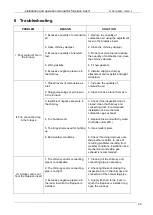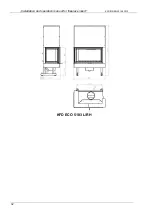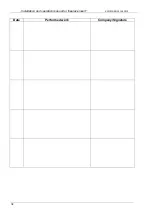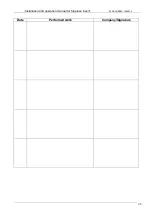
„Installation and operation manual for fireplace insert”
KFDECOENG1.1562012
20
2.3.1 Adjustment of primary air supply
Primary air is supplied from the bottom, along the furnace board, at a quantity depending on
position of the bottom lever, from the outermost right position (maximum) to the outermost left
position (minimum of primary air). The quantity of primary air ought to be reduced once
flames spread and the temperature increases.
2.3.2 Afterburning of gases
– impact of primary air supply adjustment
Once the process of lighting up ends and the temperature inside the furnace grows enough
to clean the chamotte panels from soot (pyrolysis), primary air supply ought to be reduced,
whereas air supply in the upper zone of the furnace is to be increased. This takes place
automatically once the bottom lever is moved into the central position. If the lever is moved
further to the left, this causes reduction of primary air quantity and slowing down of
combustion along with greater efficiency of gas afterburning. Operation within the range from
the central position of the lever (rated power) to the outermost left position (minimum power)
is the optimum operating range for the KFD ECO insert. Basically, after lighting up and
heating up of the furnace, it is not advisable to use of the insert with considerable primary air
supply, i.e. with the adjustment lever from the centre towards the right. Apart from greater
quantity of contaminations produced as a result of too fast and incomplete combustion, using
the fireplace at such settings may cause excessive growth of power and, as a result, damage
to the fireplace.
In case of insufficiently effective adjustment of combustion rate (usually caused by excessive
negative pressure in the chimney), the flow of smoke should be reduced by means of the
damper.
2.4 Maintenance
The way of using the fireplace and the quality of wood used for combustion are crucial to the
phenomena occurring inside the furnace. This requires periodic inspections and maintenance
of the fireplace and cooperating elements. Only original parts supplied by the fireplace insert
manufacturer may be used as spare parts. Moreover, the duct supplying fresh outdoor air for
combustion must be kept in a passable condition.
NOTE! Access from outside of the fireplace insert enclosure must be ensured for cleaning
the fireplace insert and connecting pipe, i.e. the connecting element between the insert and
the chimney
.
2.4.1 Chimney
The foundation of proper and safe fireplace operation is properly cleaned and maintained
chimney. Polish regulations require cleaning and inspection of the chimney at least four times
a year. However, experience shows that the frequency may increase in case of a chimney
without sufficient thermal insulation or if non-seasoned wood with the humidity over 20% is
used as fuel, or wood of coniferous trees. In that case, the risk of soot ignition in the chimney
increases considerably as a result of build-up of a thick layer of inflammable creosote
deposit, which needs to be removed on a regular basis. A similar phenomenon occurs inside
the fireplace insert, especially if it is operated for a long time at a considerably reduced
power. Although depositing of creosote inside the fireplace insert is not dangerous, it ought to
be avoided because of the risk of corrosion and premature wear of gaskets which
– while
absorbing creosote
– become glued and lose their properties fast.
Cleaning of the chimney ought to be performed by a qualified chimneysweep. Along with
maintenance of the chimney, fixed pipes connecting the fireplace insert with the chimney
ought to be cleaned. The connecting pipes ought to have cleaning holes, accessible through
grates or doors in the fireplace enclosure.
















































